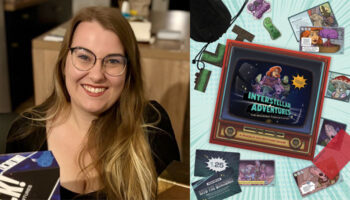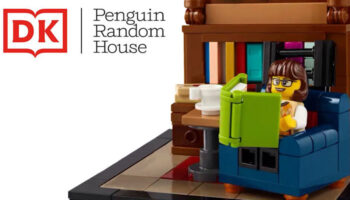Crayola’s Joseph Moll on evergreen core play patterns… And the secret of creativity

Inventor Relations guru on what he looks for in ideas, how to pitch and why he’s always talking to scientists.
Joseph Moll, you’re Director of Product Design, Innovation, and Inventor Relations at the mighty Crayola… But you have over 30 years in the industry. How did you get into it?
When I was in college I never thought of going into the toy industry. We all had visions of working for a big, consumer-product company doing sleek styled products. About a week after I graduated from the Philadelphia College of Art a friend told me about a design model shop that was hiring for toy design.
Purely mentioned in passing?
Yes. And with my finances as they were, I decided to interview! I got the job and have been in the industry ever since. I still remember the first toy I worked on was the rhino vehicle in the ANIMAX line of products by the Schaper Manufacturing Company. The excitement of the constant need for innovation and invention has kept me in the industry with its diversity of products and the challenges they present.

Out of interest, then, with which toys and games did you play when you were younger?
I grew up in the 1960s so some of the popular toys of the time were Hot Wheels and Matchbox. I used the garden bricks to build shapes and fill them with dirt to make ramps and stuff usually followed by a lecture from my mom. My favourite toy was the Zeroid Commander Action Set, with cool robots and accessories.

That rings a vague bell… There’s a robot in a wheel? Moves itself forward?
Yes, you place the robot in the wheel and the robot’s treads roll it forward. Also, the cool thing is the accessories were powered by the robot’s batteries using the hands to connect the circuit, if I remember correctly. I also loved my 12” G.I. Joe figures and the vehicles that fit him… I had the space capsule, the helicopter with the thumb-powered spinning blades, and jeep with the spotlight trailer – so awesome.
Do you still have any of that?
I’d love to say I still have them! When my parents divorced, though, we moved from New York to Pennsylvania. We left them with a friend of my mom. I never saw them again.

Arrrrgh! I’ve turned a nostalgic moment into one of quiet tragedy…
The interesting thing is that the same core play patterns from when I was a kid are still popular today. There are easily a dozen toys and games that have passed the test of time from the 1960s and are still being sold at retail. This has always lead me to believe that popular kid play patterns don’t change – just new technologies change how we do them.
Can you give a “for instance”?
A good example, I think, would be vehicle play. It’s gone from Hot Wheels and Matchbox, to RC Cars, to VR driving games. Balsa wood planes changed into drones. The adventures you created in your imagination with green army men and action figures has grown into online gaming – with tons of content creating new worlds of imaginary play. Understanding these evergreen core play patterns and pairing them with new technologies and trends is a good foundation for a successful product.
Great examples! And that isn’t a surprise as I gather you’re an inventor in your own right. So what do you think is the secret of creativity?
I think the secret to creativity is being able draw a line between non-related things that work on their own, but work better when d. Looking at these inspirational disconnected things not as what they are, but what they can be if brought together when looked at from a different point of view.

And if I want to have more ideas, what advice would you give me?
There are so many talented people working in so many different industries, all creating awesome things. You may never meet these people… But you should try and leverage this cross-industries pool of talented people, and thinking, from your point of view. That benefits your own creative process.
You’re the first person I’ve spoken to in ages that talks about this. I agree completely. This sort of cross-pollination, this transfer of knowledge, is very rich. In practical terms, though, how do you leverage it?
I leverage this pool of extended talents with the right click! In other words, when I’m poking around the internet for inspiration, I right click a lot. I save things I find interesting…
Just interesting? Unrelated to other things?
Exactly – they may not have anything to do with what I’m currently researching. But you never know what might prove useful in the future. I’ve been filing images away in category folders for years for future inspiration… Good ideas are timeless – and also timely. A middle of the road idea today may be a genius one in a year from now based on trends in the marketplace or a new consumer need.
I’m loving this! We’ll go over time, but give me another!
Another way to inspire creativity is to think of the end result, then figure out how to get there. When I was working on Tyco RC, the commercial was everything when selling the product. So I’d challenge my team to storyboard a commercial, then design the product to make that commercial. This can apply to every aspect of a product. If there’s a process – like in most Crayola products – I ask if there a new way of doing it that is better for the user? Creativity is not limited to only big things, applying it to the simple details in a product can make all the difference to the user experience.

Brilliant. I could talk about this all day. Well – conversely, then, what – to you – is creative kryptonite?
Ironically, I’d say TIME! We all work to production schedules, but some parts of it are easier to define verses others. Deliverables like tooling, safety testing, printing packaging, shipping and so on tends to follow a consistent amount of time.
The sort-of back end stuff; the practical matters?
Yes. The fuzzier front end of creating new products is harder to put into a predetermined time frame. Depending on your company, you may only have certain times of the year in your product development cycle that you work on new concepts. Being creative while shepherding current products through the development process can be difficult while working on current deliverables.
This is where some of the thinking in the question about being creative comes into play. For most people, creativity isn’t a light switch you can turn on and off. Rather, it’s a process… Creativity for new products needs to be daily thing, even in the smallest way. Right click something you find interesting… Screen grab an article about a new technology or trend for future reference when you have time to work on new concepts. Lean into the inventor community to help support your product pipeline with external innovations. And while beautiful sketches are awesome, hands on experimentation is priceless.
In what way, specifically?
Knowing how something works is more useful than a sketch showing how it might work. If you or your team have a little down time, actually sit down and try competitive products or use your own company’s products to see if you can make little changes to improve the user experience. This can even springboard you to something new that you were not even thinking about.

So when people pitch ideas to you at Crayola, what are you looking for?
Product concepts that fit the Crayola DNA, with new and unique creative experiences or play patterns. Concepts that build on product components or versions of what we already produce, sticks, paints, compounds… Protectable IP is another thing that’s become an important factor in considering submissions as there have been several competitive products copying our products introduced into the marketplace recently.
All that said, our policy is that we don’t accept submissions from the general public. If you’re an established inventor or design company, please contact me and I’ll send the submission paperwork, and information on the process after the concepts are received.
Let me ask you this: safety concerns aside, are there any things that make new ideas an immediate no for you?
Nobody likes writing letters to inventors saying you’re passing on the concept they submitted. An immediate no would be if Crayola is currently or recently developed a similar concept as the submission. One of the first things I do when I get a concept that seems like it could already exist is to do an internet search…
Just to see if something similar’s out there?
Yes. You’d be surprised how often you can find an existing product similar to a concept submission. It might have a very minor variation… But inventors doing submissions to any company should do their homework before spending time developing a concept. When submitting to companies, inventors should ask themselves if the concept is new and unique to the marketplace, patentable, and fits the product categories – and price ranges – the company they’re submitting to produces. And their retail locations, too.

And what’s the process after that? What happens to a great idea after you first see it?
I regularly schedule meetings with my marketing partners to review submissions we receive from inventors. This review consists of a small group decision makers of cross-functional team members. We keep the people that review the submission limited so external submissions don’t find a way into the general team’s thinking. If we’re interested in exploring the submission, we come to an agreement with the inventor to validate the concept with consumers, run preliminary costs, some basis research and development, and a check on patentability.
What happens to the “also rans”?
If we decide to pass on an idea, I feel the best thing I can do for the inventor is not to just send a letter saying that we’re passing on the submission. I try to put together a detailed explanation of why we’re passing, thinking this provides them with things to consider the next time they submit a concept.

That’s unusually conscientious; that must be appreciated…
We also try to do all the above in a timely fashion, but the real world sometimes does not allow for that. Scheduling meetings that fit multiple people’s schedules, and making decisions early in the year for concepts that fit a later season when we haven’t begun to explore it sometimes causes delays. But items that we know won’t fit the product line have a pretty quick turn-around.
I was quite taken, when we met, with Crayola’s Paper Flower Science Kit. It’s a craft set that lets you make flowers that change colour as water wicks into their petals. How does a scientific principle like that – capillary action, I guess – turn into a product?
Binney and Smith – Crayola – originally started as a chemical company. And, to this day, we have a full department of scientists… Coming up with new product concepts isn’t limited to only the design department. When marketing outlines the needs for the upcoming product lines, they’re shared with all the cross-functional team members…

And because all those teams participate in product brainstorms, some scientific principles work their way into products. This is where your question about creativity comes into play…
A person may not know what to do with a piece of cool technology or a little gem of chemistry. But putting them out there so others can look at them from a different point of view ends up creating new and unique ways of using them. In a vacuum, simple technology and chemistry might not be so special, but sharing it with the team with different viewpoints can open up so many possibilities.
You make it feel like anyone can do it; it’s genuinely quite motivating!
There is a great kid’s book called ‘What do you do with an Idea?’ by Kobi Yamada. If you haven’t read it, I’d recommend it just for fun. Plain and simple: believe in and share your ideas no matter what others think, they may change the world.

Wonderful. Before we start wrapping things up, is there a question you’ve never been asked that you think it would be interesting to answer?
Oh… I guess: what career would you have chosen if you didn’t go into the toy industry?
That’s good! Let’s go with that!
I’d like to have worked in the furniture and household fixture design. I love the smell of cut wood and doing house renovations, that sort of thing… Anything from simple projects to gutting kitchens and bathrooms, moving walls, adding closets, wiring. That sort of thing… Then finding cool affordable stuff to fill these new spaces. And we have a 120-year-old house which constantly provides opportunities to do the above!
Last two things, then: if you were to write your autobiography, what would you call it?
Behind the Scenes…
Interesting. For what reason?
For the majority of my career I’ve not been the person associated with the products I’ve worked on. My first job out of college in the mid 80s was for a prominent design/model shop. I took the rough concepts from designers and gave them dimensional shape for major toy companies at the time: LJN, Tyco, Childbro, Cap Toys, Schaper, Kenner, Hasbro, Larami, Entertech, and The Franklin Mint…
The collectible product people?
Exactly. So, I was creating multi-view engineering drawings of the exterior of each product, then laying out their complicated mechanical functions and the parts assembly for production. I’d send the drawings to the toy companies – and only things that would change was the name in the title block.
Ah, I see. Yes…
I was fortunate to work on some great toy product lines of that time: Thunder Cats, Dino-Riders, Crash Test Dummies, Visionaries, Mask Relaunch, Animax, BattleTech, Super Soakers… It’s not a big deal now but back then I was one of the first designers doing these types of drawings in CAD. I dove into learning Autocad when my boss offered me this opportunity, mainly because I hated doing control drawings on paper.

What was it about that? What’s to hate?
Anyone who did complicated engineering drawings on paper back then would understand the horrors… Smudging, running blueprints, lettering guides, erasing things and hoping you don’t make a hole in the paper! Engineers were starting to learn, but the combination of freeform shapes and creating them in CAD was challenging.
I see! Old school problems! No click to undo…
I’m showing my age! I learned to use a digitizing table and my freehand sketches to help create complicated designs in CAD. That led to learning 3D modelling and CNC programming. The model shop would make working samples and patterns with set up blocks when a lot of toy development was still done domestically, then shipped to Asia to pantograph the tooling.
From what you say, though, all this knowledge is still incredibly useful?
I think the experience from that first job has been a thread throughout my career – being able to bridge the gap between design and engineering. By understanding the needs of both disciplines in order to produce a final product. Which has led to my still continuing trips to Asia that started after Mattel bought Tyco back when England still governed Hong Kong… Flying into the old airport with fun drop when you landed. Meeting with development teams and factories to review prototypes, discuss changes, decoration, tool plans… All, hopefully, to come home with the target price.
And all behind the scenes. Love it. Last question… What’s the most-interesting object in your office?
Well… I like when packaging goes beyond just being the box to hold the product at retail. One example of this I have in my office is a Think Way toy from about 20 years ago. There’s no date on the box but the batteries still work!

Anyway, I had one in my office at Mattel and purchased another one while working at Crayola as an example of interactive packaging. It’s a robot called a Gundam. But what makes this box so special is that they built the TV commercial into the box. When you press the Try Me button, the Gundam lights up and the box plays a voiceover of features and music. This is in sync with a colour transparency, like a film strip on the front panel of the box. Each frame lights up from top to bottom highlighting the individual features of the Gundam.
Brilliant. I’m so glad you’ve made time for this, Joseph; absolutely fascinating, thank you.
—-
To stay in the loop with the latest news, interviews and features from the world of toy and game design, sign up to our weekly newsletter here





















